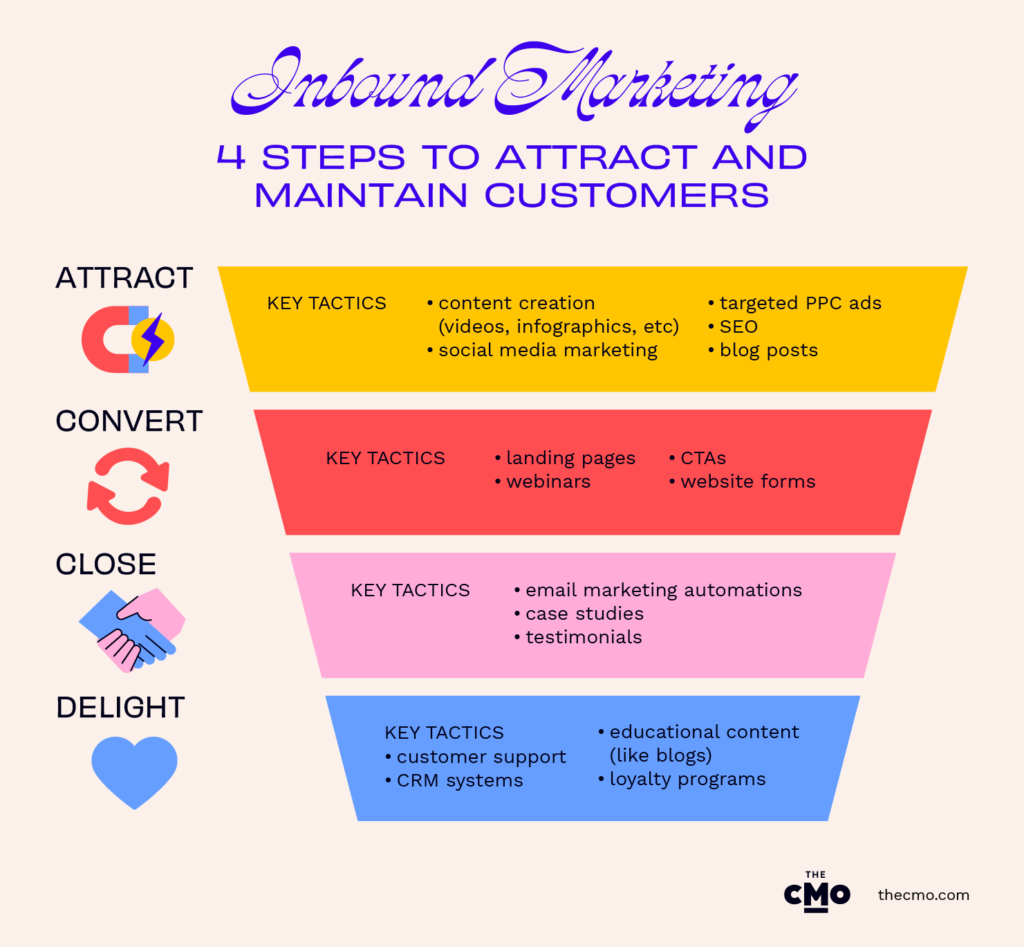Inbound marketing helps SaaS businesses attract high-quality leads by offering valuable content that addresses customer needs. It's cost-effective, builds trust, and provides measurable results, making it a smart choice for sustainable growth.
In this article, I’ll walk you through the top benefits of inbound marketing and how they can help your business grow.
What Is Inbound Marketing?
Inbound marketing falls under the digital marketing umbrella, using high-quality, value-driven relevant content that attracts and engages ideal customers.
What does that content look like? Think blog posts, content creation for organic and paid social media, optimized landing pages, search engine optimization, and email marketing, to name a few.
When using these mediums in your sales funnel, there are four essential steps you’ll want to lead potential customers through to help build trust and maintain their loyalty:

1. Attract:
New customers always start as strangers, so the goal is to first increase awareness around your brand and get potential customers interested in what you have to offer.
How can you do this? With highly relatable and valuable content.
Hook your ideal customers in with messaging that’s deeply relatable to them and the pain points they face on a daily basis. Their curiosity will then take over and encourage them to learn more.
E.g. Quickbooks attracts small businesses with the hook “Get Paid Faster,” because they know it’s a pain for business owners to deal with late payments.
Key tactics to help with attracting leads could include content creation in various mediums like videos and infographics, social media marketing, targeted PPC ads, SEO, and blog posts.
2. Convert
Once you’ve successfully attracted qualified leads into your pipeline, you enter the “convert stage” of inbound marketing. Now it’s your time to really shine by showing potential customers how the features and benefits of your solution will improve their lives.
At this point in Quickbooks’ buyers’ journey, all website traffic is shown a lead magnet offer to sweeten the deal. E.g. “50% off for 3 months.”
Other key tactics to help convert leads could include landing pages, webinars, CTAs, and website forms.
3. Close
Your job at this point in the sales funnel is to nurture the lead, so they become undoubtedly confident in your brand as a viable solution. This involves providing tailored content that addresses their concerns, showcasing the benefits of your SaaS solution, and helping them overcome any objections they might face before purchasing.
At this point in the Quickbooks funnel, they promise ”free unlimited support” and “no contract, cancel anytime” messaging to help combat those common objections.
Key tactics to help close a deal could also include email marketing automations, case studies, and testimonials.
4. Delight
Only 45% of software buyers renew without consideration, meaning, if you don’t make the effort to impress your customers after they purchase, you open yourself up to the majority of them looking for alternatives.
Delighting your customers means providing exceptional post-purchase experiences that fosters long-term relationships and alleviates any form of buyer’s guilt. Happy customers are more likely to become brand advocates, refer others, and even make repeat purchases.
Tactics to help delight your customers could include customer support—like Quickbooks’ promise—CRM systems, educational content like blogs sent via email marketing, and loyalty programs.
If you’re asking how these benefits stack up to the benefits of outbound marketing, I believe inbound tactics will win every time. But let’s look at the difference between the two, so you can see for yourself.
Inbound Vs Outbound Marketing
One of the greatest things about inbound marketing is that it’s a two-way street—customers facing a problem and wanting a solution, and sellers providing that solution.
This blog is actually the perfect example:
You are in the SaaS sector and are interested in learning more about inbound marketing for your business. To start learning more, you may have typed into Google “is inbound marketing good for SaaS businesses?”
Because this article uses strategic SEO and keywords, it then showed up for you when you started your search. In other words, you showed interest and I ensured The CMO’s inbound marketing provided you with the answers.
How meta is that?
With outbound marketing, it’s more of a chase, as sellers use more traditional methods like cold calling, billboards, and commercials to find interested customers from a bigger pool of people.
These methods are less cost-effective and come with less data to back up their success, making it much harder for your sales and marketing departments to track their ROI. Now that you know the difference between the two, let’s dive deeper into how inbound can benefit you.
The 8 Benefits Of Inbound Marketing
1. Increased Brand Awareness
When you take the time to regularly create educational, insightful content that’s highly relatable to your target audience, brand awareness will naturally follow.
High-value content with your name attached to it is a great way to not only become an authority figure in your industry, but it sets you apart from competitors as well.
Having this authority in your space opens you up to positive word of mouth, recommendations, increased credibility through testimonials, and subsequently, more awareness around your brand and service offerings.
2. Quality Traffic and Leads
Because inbound marketing tactics focus on attracting leads who are genuinely interested in your solution, you don’t end up paying to cast an unnecessarily wide net and have the wrong eyes viewing your content.
By producing quality content aimed specifically at your target audience, you’ll attract higher quality leads who are more likely to become paying customers.
3. A Modernized Approach
It’s no secret that digital marketing is more modern than traditional marketing methods, and as we’ve said, inbound marketing falls under the digital marketing umbrella.
Using digital tactics has the ability to generate 50% more interactions with customers than traditional marketing, which makes sense since the content is more targeted, personalized, and can span the entire internet without the physical restrictions of, let’s say, a billboard. It’s also easier for customers to take a desired action, than if they had to write down a phone number, address, or website from such outbound mediums.
So by choosing the more modern approach, you get noticed by the highest possible number of ideal customers.
4. Higher Trust and Credibility
Using CRM systems, newsletters, blogs, etc. to your advantage will make you better equipped to provide ongoing solutions to your customers. In-turn, you help build trusted, long-term relationships and credibility among your target audience.
5. ROI and Visible Metrics
When you invest in marketing, the simple goal is to get a good ROI and Inbound marketing leads cost 61% less than outbound leads. While “good” looks different based on every business’s goals, data has to actually be trackable in order to know whether you’re hitting those goals or not.
Where outbound marketing efforts, like commercials, can show you how many people had their TV or radio on during your ad, Inbound marketing tactics provide a much deeper look into viewers to offer you insights on their behavior, demographics, psychographics, and interests, so you know if the ideal people are getting exposed to your brand.
By analyzing this data, you can gain valuable insights into what's working and adjust your strategies accordingly to improve your ROI.
6. Simplified Sales and Marketing Work
When you use inbound tactics like SEO, email marketing, PPC ads, or CRM systems effectively, you have the ability to significantly streamline your workload.
Email marketing alone can be set up to effectively market and re-market your software to a targeted group of leads who have already shown interest in your brand. From there, using strategic, goal-driven CTAs help to close the deal! This eliminates the need for a large sales team, and automates some of the marketing funnel as well.
7. Sustainability
Content like blog posts, SEO, videos, and social media posts have the organic ability to continue to attract traffic and generate leads long after they've been published. In fact, being consistent with inbound marketing for 5 months, brings the average cost per lead down 80%. This means inbound marketing efforts have a lasting impact that continue to contribute to sustained growth.
8. Content Distribution
When you create content for digital marketing, you have the ability to reuse each piece of content across various platforms to expand your distribution. If you use pay-per-click (PPC) ads in your inbound strategy, for example, just one piece of content can be used on Facebook and Instagram, Google, Pinterest, LinkedIn, and if it’s a video, even Youtube!
Of course, in order to reap these eight benefits, you’ll want to ensure you’ve properly optimized your inbound strategy with the following three key considerations.
3 Things To Consider When Building Your Inbound Marketing Strategy
There are three principles that guide every successful inbound marketing campaign:
1. Identify who YOU are
Before launching a campaign, it’s essential to know who you are as a brand and to keep that identity consistent across all marketing platforms.
E.g. When creating content, you wouldn’t want to use messaging that comes off casual and playful on one platform and hyper-corporate and serious on another, because it prevents customers from getting to know the real you.
So figure out your core values, brand personality, and how you want customers to view you before making any marketing moves.
2. Identify your buyer personas
I’ll start by saying “everyone” can not be your target audience. If you’re currently planning to launch a campaign with the goal of selling to everyone with a credit card, it’s time to go back to the drawing board.
Before launching any campaign you need to have a solid understanding of who you want to target and why they’ll care about your offer. E.g. A social media manager isn’t going to care about a software that helps accountants file taxes faster, so it would be a waste of money to target them. That’s why the more you can tailor your content to your ideal customers, the more quality leads will be drawn to your brand.
The best marketing strategies dig into what drives their customers and provides personalized solutions. Understanding your ICP (ideal customer profile) is so important, in fact, that it's our number one inbound marketing tip.
3. Identify what you can optimize
The digital world is never stagnant, which means you have the opportunity to constantly adjust and optimize your marketing strategies, even after they’ve been released into the world. Always keep an eye on your analytics, take note of what’s working and what isn’t, and don’t be afraid to make adjustments.
Now You’re Ready To Go Inbound!
The most important thing to remember about anything in the digital world, is that it’s always evolving. Your inbound marketing strategy should therefore be adaptable based on market trends, customer feedback, and changing technologies. Set your inbound marketing objectives and goals in the beginning, and always be ready to iterate and optimize.
If you take what you learned here and combine it with a willingness to adapt based on what you learn from your own analytics, you’ll create an effective inbound marketing strategy that drives success for your SaaS business.
If you’re curious about other digital marketing strategies, browse through our library of topics, and make sure to subscribe to our newsletter to keep up with all things marketing and leadership.


